Analysis: Over 500 people will run for election to the 34th Dáil so what do we know about these candidates and selection trends to date?
As of now, we know that over 500 people will run in the upcoming general election. This includes sitting TDs, senators and councillors, as well as former TDs and other people have previously held electoral office, in addition to a number of first time candidates. All have either been selected by parties to contest the general election or, in the case of non-party candidates, have declared an intention to contest the upcoming election. So, what do we know about the candidate selection trends based on what we have seen so far? Here are five takeaways.
More women candidates than at any other time in the history of the State
Given that the gender quota is increasing to 40% for this election, this is perhaps not that surprising, but the extent of the increase may well be greater than might have been anticipated. As of November 4th, 193 female candidates have been selected to run in the general election by the different political parties (42.1% of all political party candidates).
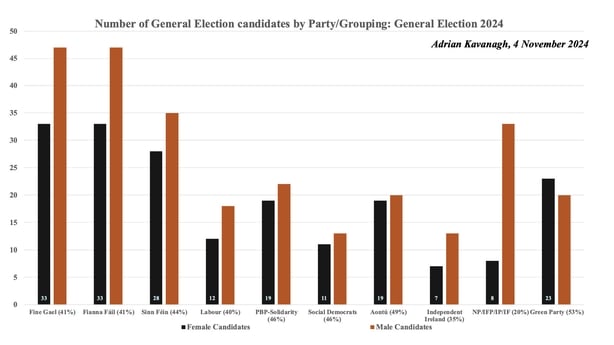
A further 24 women have declared an intention to contest the election as non-party candidates. As it is hard to find 100% accurate information on non-party candidate declarations, this latter figure is undoubtedly an under-estimate of the total number of female non-party candidates who will appear on ballot papers across the State. The overall number of selected/declared female candidates, as of now, stands at 217, marking an increase of 55, or 34%, on the previous record level (162 at the 2016 General Election).
At this point, the Green Party has selected more female candidates than male candidates, while Aontú is very close to having an equal number of female and male candidates. Most, if not all, of the larger parties seem to be well on track to achieve the 40% gender quota target.
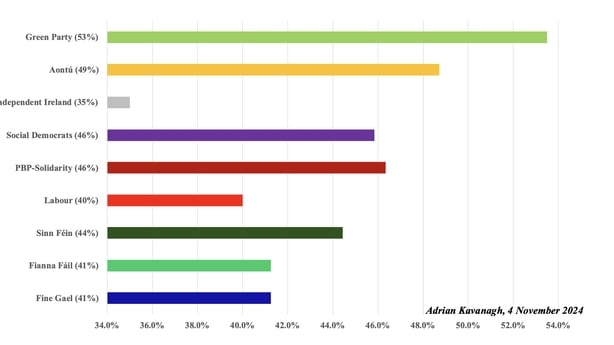
At the 2016 and 2020 elections, Fianna Fáil and Fine Gael struggled to achieve the 30% gender quota target. Both often had to revert to adding extra female candidates, with many being added almost at the last minute to reach the quota. Many of these were untried in electoral terms (to the extent that it might be argued that some could have been almost viewed as "paper candidates").
Both Fianna Fáil and Fine Gael have generally managed this time around to remain on target to reach the gender quota target, despite the increase in this from 30% to 40%, as constituency-level selections have progressed. The final female candidacy levels for FF and FG will probably come in just above the 40% level, whereas female candidate levels for other parties, such as the Green Party and Aontú (as noted already), as well as People Before Profit-Solidarity and the Social Democrats, will be higher.
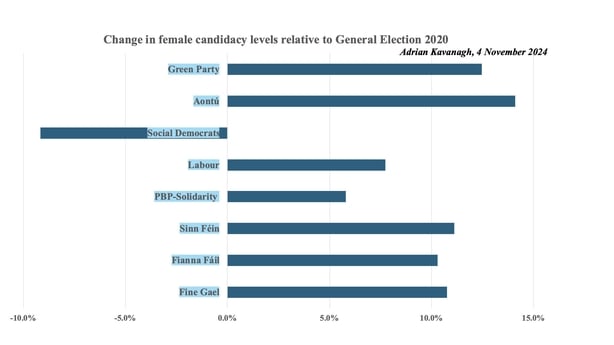
Some parties have seen a notable increase in their female candidacy levels at these elections, with the biggest increases being associated with Aontú (as of now, seeing an increase of 14.1% relative to their female candidacy level at the 2020 election), the Green Party (12.5%), Sinn Féin (11.1%), Fine Gael (10.8%) and Fianna Fáil (10.3%). The female candidacy level for the Social Democrats has fallen (as of now, by 9.2%) relative to their 2020 level, but this does reflect, in part, the party's very high female candidacy level (55.0%) at the 2020 General Election.
No party will run enough candidates to allow them form a single party government
The two traditional larger parties that used to dominate the Irish political system for most of the State's history, Fianna Fáil and Fine Gael, now tend to run fewer candidates than they did in the 1900s. This reflects the increased levels of political fragmentation that have been part and parcel of Irish politics over the last two decades. It's not by any means certain, but it seems highly unlikely at this point that any party will run enough candidates to form a single party government if all/most were successful and this will be the first time that this has happened in the history of the State.
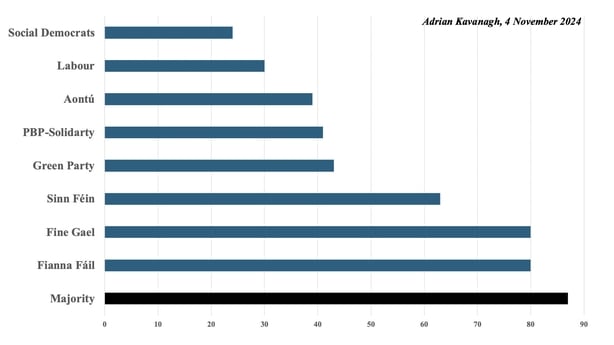
The last single party Government in Ireland left power in 1989, but over the following decades either Fianna Fáil or Fine Gael – and usually both parties – tended to run a large enough number of candidates at general election contests to ensure they could form a single party government if all, or even most, of their candidates were elected. Even in the last three general elections, when the combined vote share of these parties was much lower than in previous decades, Fine Gael ran enough candidates to be able to form a single party government if all/most of these had been successful, while Fianna Fáil also did so for the 2020 election.
The weekend selection convention for Fianna Fáil in Tipperary North and tonight's gathering for Sinn Féin in Laois means the four largest parties have now completed their constituency selection conventions. As of now, both Fine Gael (80) and Fianna Fáil (80) are some distance short of the number (87) needed to be able form a single party government in the next (174-seat) Dáil. Both parties may well add more candidates in the next few days before they finalise their candidate lists but are unlikely to add more than a handful of candidates. While Sinn Féin will run more candidates than they did in 2020 (likely to be around 70, given the expectation that the party is set to add a number of candidates in the next few days), their number of candidates will also fall well short of the number needed to form a single party government.
We need your consent to load this rte-player contentWe use rte-player to manage extra content that can set cookies on your device and collect data about your activity. Please review their details and accept them to load the content.Manage Preferences
From RTÉ's Know Your Constituency, Laois was previously seen as a relatively predictable constituency, but recent controversy surrounding Sinn Féin and Brian Stanley now means it will be keenly-watched as the campaign plays out
The rise of 'New Irish' candidates
New Irish candidates – which I will take here to mean candidates who were born outside the Republic of Ireland and did not attain Irish citizenship until some years after they moved to Ireland – have been a feature of local election contests over the past few decades. This year's local election contests saw a record number of New Irish candidates - and indeed a record number of successful candidates.
However, these candidates have not been a feature of general election contests up to now. This, I suspect, is mainly down to the fact that the right to vote in these contests is limited to Irish and British citizens (aged 18, and over), who are resident in the Republic of Ireland, whereas the right to vote in local election contests is open to all who are resident in the Republic of Ireland and who are aged 18, and over.
We need your consent to load this rte-player contentWe use rte-player to manage extra content that can set cookies on your device and collect data about your activity. Please review their details and accept them to load the content.Manage Preferences
From RTÉ's Documentary On One, The Indian from Clare looks at the 1992 General Election success of Mossajee Bhamjee in Clare (first broadcast in 1993)
Some New Irish candidates did contest past general elections as independent candidates, but achieved little in the way of success in recent years. One of the most high profile of these candidates was former Laois county councillor, Rotimi Adebari, who won 628 first preference votes in Laois-Offaly at the 2011 election. Of course, Mossajee Bhamjee did of course win a seat for the Labour Party in Clare at the 1992 election.
This year’s election, however, sees a number of New Irish candidates being selected by political parties. Cllr. Helen Ogbu will contest Galway West for the Labour Party, for instance, while Monaa K Sood (Kildare South), Carol Okeke (Longford-Westmeath) and Monica Oikeh (Cork South-Central) are contesting the election for the Green Party and Manju Devi is contesting Dublin Fingal East as a Fianna Fáil candidate.
There are going to be some very long ballot papers
There often tends to be very notable differences in terms of the number of candidates running in different constituencies. Urban constituencies often tend to have slightly larger numbers due to the larger number of political parties/groupings that tend to contest these as compared with the more rural constituencies, and the number of candidates is often, but not exclusively, related to the number of seats being contested in a constituency.
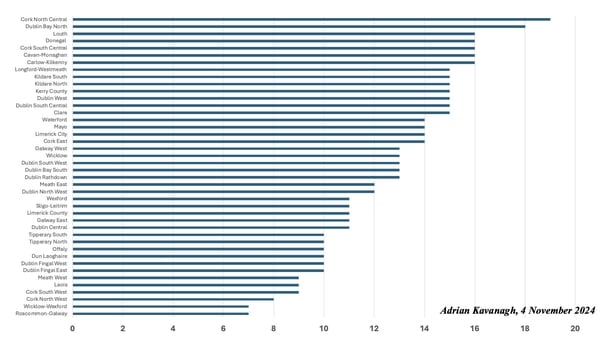
At the 2020 election, 20 candidates contested the Wicklow constituency, while only 9 candidates contested the Cork North-West and Meath West constituencies. The degree of variation between the constituencies with the biggest and smallest number of candidates was even greater at the 2016 election, with 21 candidates contesting Dublin South-West and only six candidates contesting the Laois constituency.
As the accompanying graph illustrates, there will again be notable variations between constituencies in terms of the number of candidates contesting these – allowing, of course, for the fact that we do not yet have the final, definitive, candidate list for these constituencies. As of now, it appears that there will be very long ballot papers in a number of constituencies, with Cork North-Central and Dublin Bay North, in particular, pushing very close to the 20-candidate mark, as of now.
We need your consent to load this rte-player contentWe use rte-player to manage extra content that can set cookies on your device and collect data about your activity. Please review their details and accept them to load the content.Manage Preferences
From RTÉ's Know Your Constituency, there's a Grand National field lined up for the five seats in Dublin Bay North, with just two incumbents returning and several candidates in the political last-chance saloon.
A large number of political parties will contest this election
In contrast with countries using first-past-the-post electoral systems – the US with just the Republicans and Democrats being a very obvious example here – Ireland's PR-STV electoral system allows smaller parties and independents the chance of representation, especially in areas/constituencies where that party’s support is especially strong (and where they also might be in a position to avail of vote transfers). The increased levels of political fragmentation in the Republic of Ireland over the past number of decades – contrasting with the 1969 election in which all, bar one, of the seats were won by either Fianna Fáil, Fine Gael or Labour (and no other party won a seat at the 1969, 1973 and 1977 elections) – has, in turn, seen an increase in the number of parties winning seats in Dáil Éireann.
The number of officially registered political parties that are represented in Dail Éireann spiked over the past year. The creation of Independent Ireland, which drew three non-party Dáil Éireann into their ranks, means there are now 10 political parties represented in the Dáil (or 11, if People Before Profit and Solidarity were listed as separate parties).
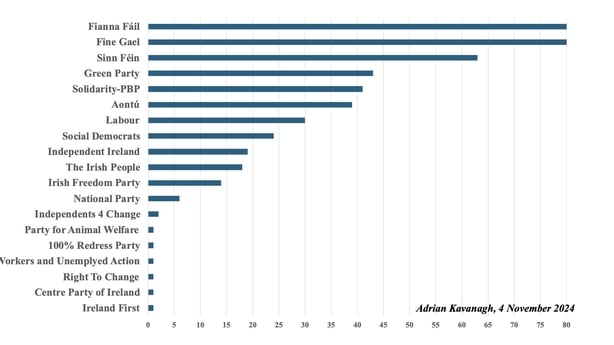
The overall increase in the number of political parties in the Dáil is also reflected in an overall increase in the number of officially registered political parties, with a number of new parties being added to the official Register of Political Parties in the months leading up to June’s local elections. There are now 30 parties on this official list and roughly 20 of these will be running candidates in the upcoming general election, although some will be running a very small number of candidates (and some may well just run one candidate).
In addition to this, there will, of course, be a large number of non-party candidates contesting the upcoming general election. 131 non-party candidates contested the 2020 election, while 163 contested the 2016 election and 197 contested the 2011 election. The overall trend across recent elections has amounted to a decline in the number of non-party candidates, although the 2011 number marked very large increase on the number of non-party candidates (107) who contested the 2007 election. The overall increase in the number of smaller political parties, especially in recent years may well be absorbing a number of people who may have otherwise decided to run as non-party candidates if these parties did not exist.
Follow RTÉ Brainstorm on WhatsApp and Instagram for more stories and updates
The views expressed here are those of the author and do not represent or reflect the views of RTÉ







